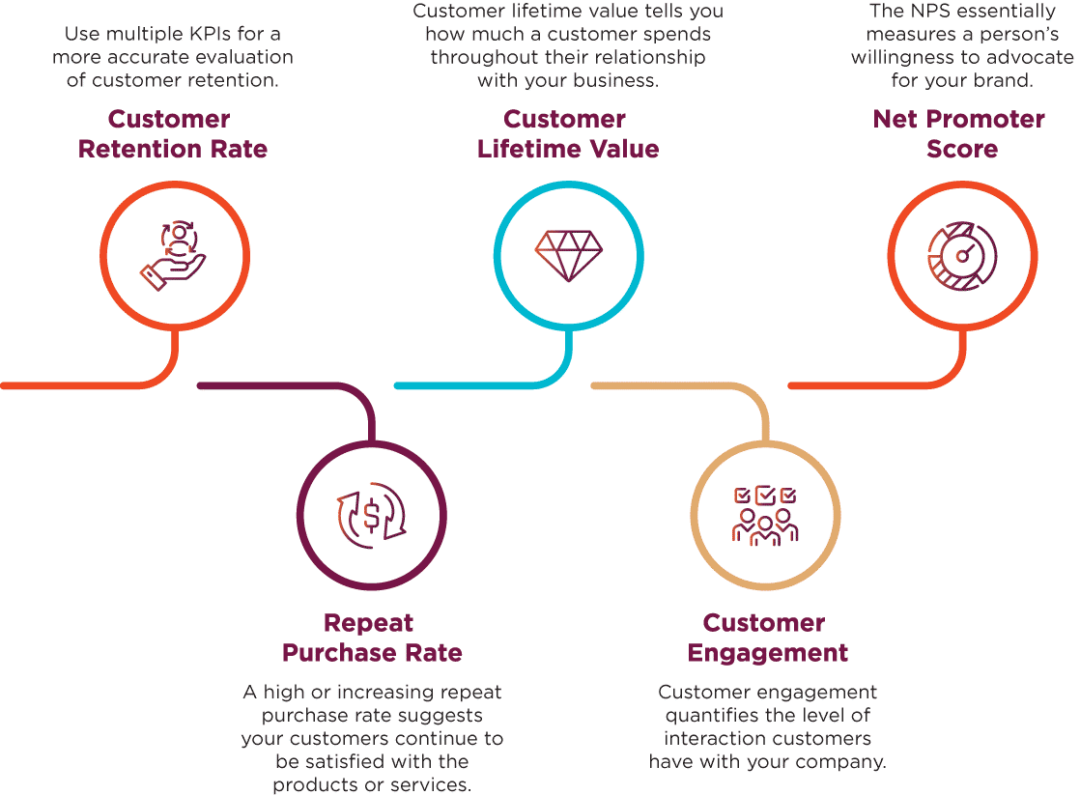Any sales or customer loyalty manager will validate that keeping existing clients is preferable to chasing new ones.
Lead generation can be a costly — and slow — effort. But, lead generation is very simple to track and evaluate. A glance at a customer relationship management (CRM) tool shows how many new leads have been generated in a day, week, month, or year. In fact, tracking leads can become intoxicating, providing quick hits of dopamine that fuel the pursuit of additional leads.
The ability to check lead generation performance easily might be why it is discussed so often. However, the reality is customer retention is also easy to track. You just need to know where to look for validation. That’s why Shutterfly Business Solutions is highlighting five key performance indicators (KPIs) that measure and prove customer retention.

1. Start with the obvious customer retention rate
Most CRMs can track your customer retention rate already. It’s often an overly simple metric. The calculation determines what percentage of your customers have remained engaged with your business over a time period. Engagement could include purchasing, requesting information, logging in to a website, and other defined actions.
As engagements increase, it’s considered a strong sign that customer retention is increasing. Often, the insights are good indicators. But they can also be misleading.
For example, calls or emails could increase due to negative press or technical glitches. They may be concerns or complaints that foreshadow a possible customer exodus.
For that reason and others, we suggest evaluating customer retention using several key performance indicators to create a more accurate picture.
2. The powerful intersection of repeat purchase rate and customer retention
One-and-done customers are nice but of marginal value. Your company wants customers that purchase on a predictable schedule or high frequency.
An individual customer’s repeat purchase rate is calculated by how many times they paid for a good or service over a period of time. That period could be as short as a week or a decade — depending on the industry, product, and price.
Now, you want to look at all of your customers, not just unique instances. Combine all of the purchases for some time, let’s say a month, and compare that year-over-year. If a higher proportion of customers make more than one purchase for that month, you have another strong indicator that customer retention is trending upward.
A high or increasing repeat purchase rate suggests your customers continue to be satisfied with the products or services.
3. The point of customer retention is increasing customer lifetime value
It’s not enough for a customer to stick around and stay connected to your company. If they don’t make ongoing purchases, they are a drain on resources rather than an asset. Or, maybe they just create some false data points. Either way, the point is to build customer lifetime value.
Essentially, customer lifetime value tells you how much a customer spends throughout their relationship with your business. Seeing the connection between retaining a customer and increasing lifetime value is relatively easy. That means the inverse is often true as well.
If customer lifetime value increases, it may indicate increased customer retention. Yes, price increases or expanding product offerings could be at play. But it may also be a result of customers starting their engagement with you sooner — or staying as a customer longer, that is driving the lifetime value up.
4. Customer engagement is the sibling of customer retention
Some people think that customer engagement and customer retention are interchangeable. They are not. But again, like the other metrics we are discussing, there is overlap.
Customer engagement quantifies the level of interaction customers have with your company. So, rather than measuring how long they’ve been a customer, it assesses how many touchpoints they’ve created through various channels. The channels can include websites, sales calls, emails, in-store visits, social media likes, and more.
The more engaged customers are with your company, the greater the likelihood of them staying around for an extended period of time. Of course, there are the fast, deep divers. Those who engage everywhere, all the time, when doing their purchase research. Those people may or may not stick around. But they are somewhat rare. Most customers who take the time to engage deeply get invested and stay committed. That commitment is the key to customer retention.
Look for signals of deepening customer engagement to indicate that customer retention will likely trend longer.
5. The net takeaway of a net promoter score
A Net Promoter Score (NPS) assesses customer loyalty and satisfaction by asking a straightforward question, “How likely are you to recommend this business to others on a scale of 0 to 10.” That’s it, but the answer is a powerful indicator. The NPS essentially measures a person’s willingness to advocate for your brand.
The stronger the willingness to suggest a brand, the more likely that person will continue using that brand. They are satisfied, believe, and trust it enough to follow their lead.
According to the scoring system, customers are classified as detractors, passives, or promoters. You want to create promoters. Those who give a score between 9-10.
By tracking NPS, you can see if your customers are trending upward to promoters, remaining as promoters, or sliding toward detractors. The higher the score, and any movement up the scale, is a good sign that customer retention will also move upward.
Bonus KPIs for reading to the end
We promised five KPIs to prove your increasing customer retention, but we’re giving you seven. That’s how Shutterfly Business Solutions likes to work — surprise and delight by overdelivering on your expectations.
Churn rate
Meet the dreaded opposite of retention rate. The churn rate measures the percentage of customers who stop doing business with your company over a period of time. While you want the retention rate to increase, you also want to see the churn rate decrease. Typically, these numbers have a direct correlation. For example, if churn drops 5%, retention should show a 5% increase.
Time between purchases
Measuring and monitoring your customer’s average time between purchases can signal customer loyalty or preference. If the time between purchases decreases, it can indicate that customer connection is growing, leading to increased retention.
Improve the ROI of your business gifting program with Shutterfly Business Solutions
Monitoring and assessing customer retention using multiple KPIs delivers valuable insights. It also helps you spot areas for improvement. That improvement, along with impacting customers, is achieved by working with a proven partner, like the intelligent business strategies of Shutterfly Business Solutions.
Shutterfly Business Solutions has thousands of insights, strategies, and solutions ready to deploy. Using our expertise, scalability, nationwide presence, and massive Shutterfly platform will maximize your communications and achieve specific business goals — like extending customer retention.
Let’s discuss how Shutterfly Business Solutions can improve your omnichannel communications in business gifting, direct mail, transactional mail, greeting cards, and books.
Capitalize on Shutterfly Business Solution resources and workflows to solve your communication challenges.



